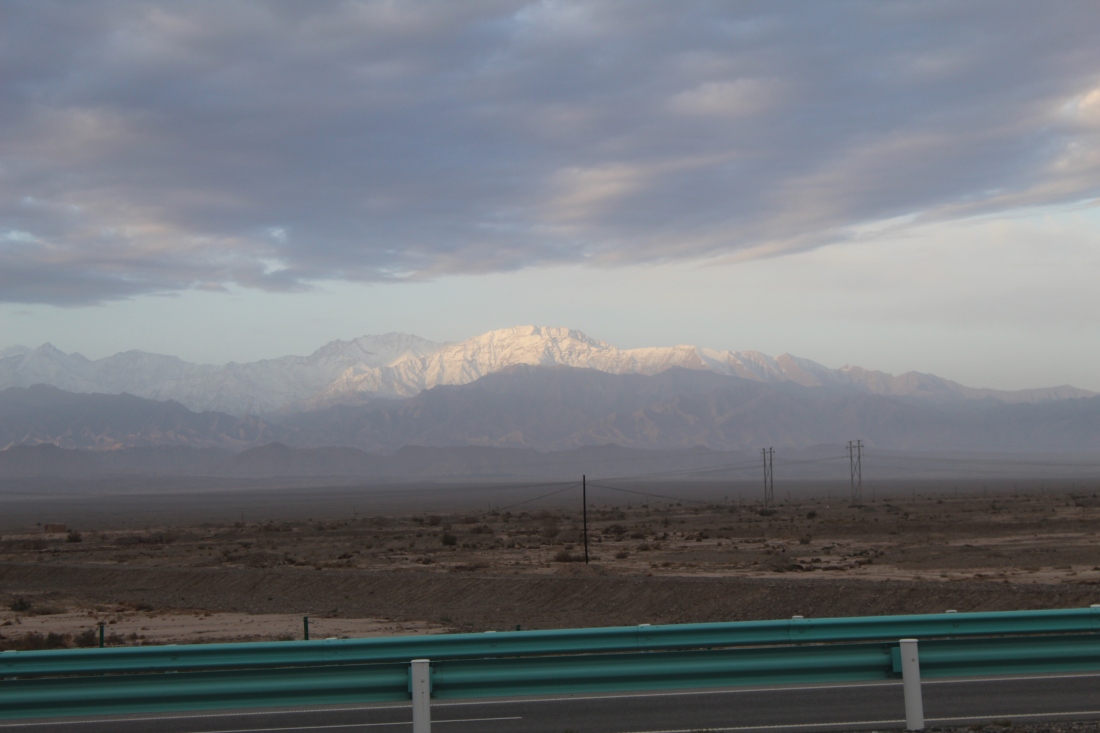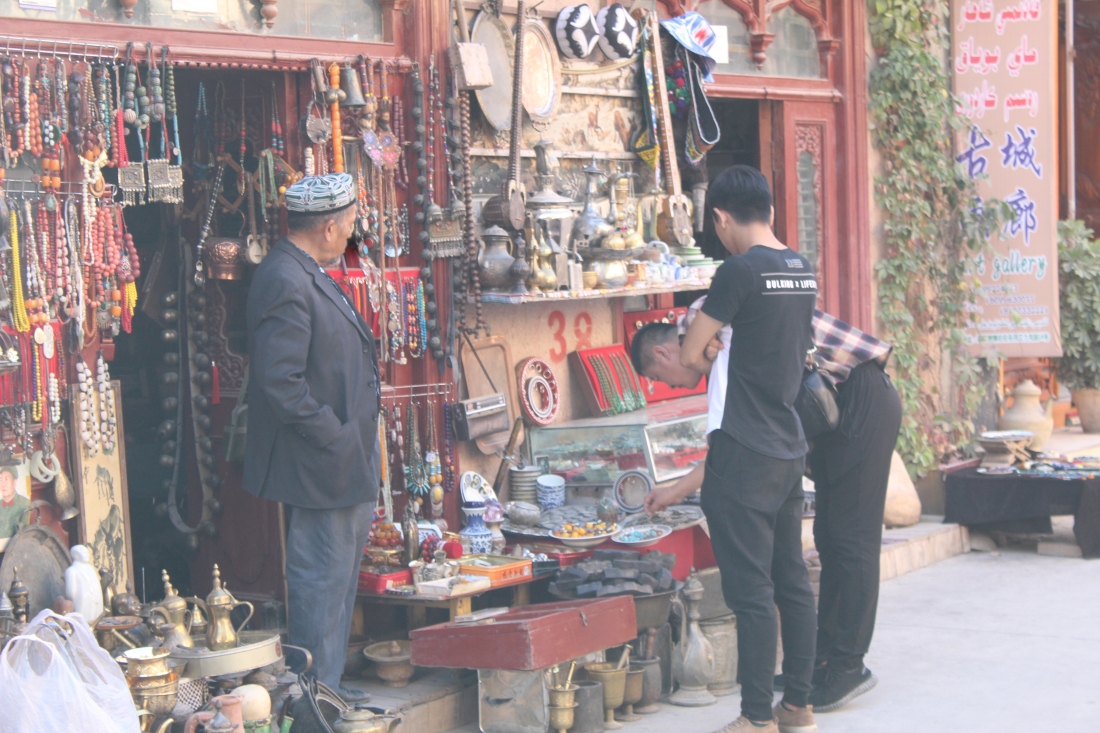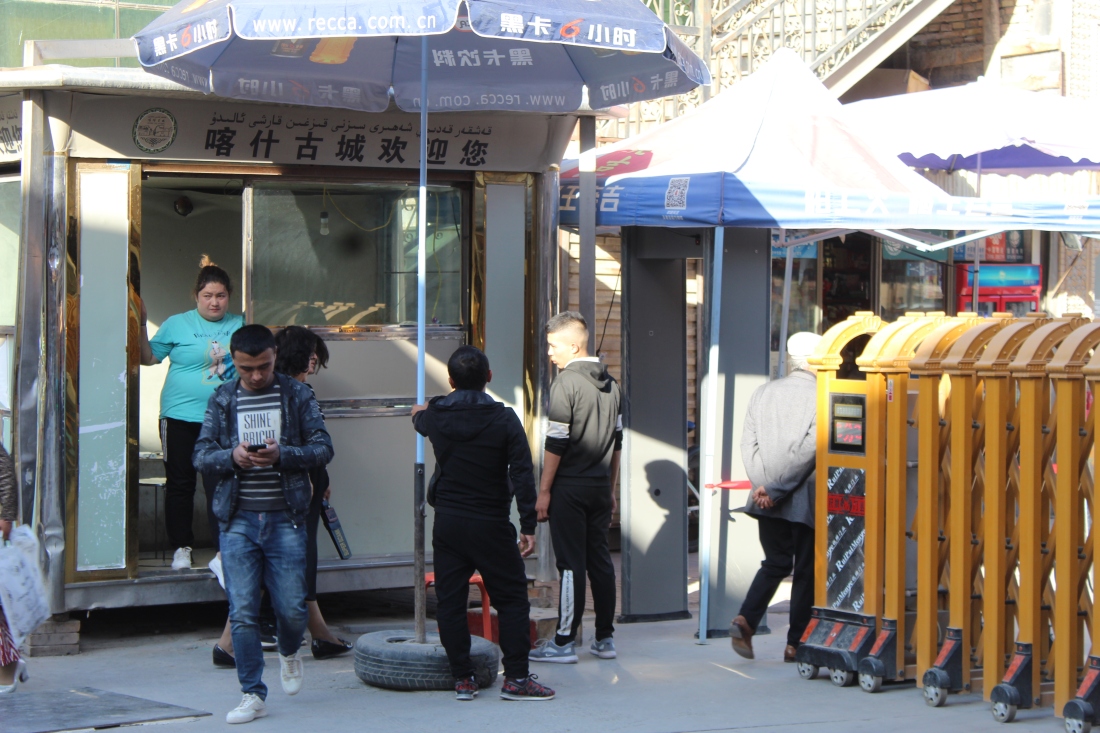With the autumn equinox now past, nights are longer than twelve hours. Usually I’d spend much of this time reading. Since my batteries were dead, I was bored and decided to set off a couple of hours before it got light.
There was almost no traffic so I wasn’t too concerned about riding in the dark. The slightly bigger problem was that the road network here was a bit different to my map, due to recently built roads. I was riding on the old highway (G315), adjacent to a newly built motorway (G3012, not on my map).
After a certain point, the new motorway took the place of the G315. The road I was on took a bridge over the G3012 and connected to a smaller road – going in the wrong direction.
I realised this when the smooth tarmac I’d been riding on suddenly had lots of potholes and patches of sand. I made my way back over the bridge and rode along the motorway for a while. Barbed wire fences prevented access but eventually I found an unlocked gate and let myself in. It was just starting to get light as I pedalled along the motorway.

I wanted to get some food, so after a while I decided to leave the motorway and detour through a town. There was a police checkpoint, however, and they would not let me through. I was told that if I waited a while they would call in more officers who would escort me to a shop. I couldn’t be bothered with that, so I returned to the motorway.
Before too long I got a puncture in my rear tyre. After removing the offending thorn, I put in a spare tube. I was trying to preserve my patches – I only had half a patch left after repairing about ten punctures the day before.
The puncture occured during a brief gap in the desert. There were a few towns nearby and the motorway passes by some farmland. I could see lots of people picking cotton in a nearby field.

Later on there was a rest area next to the motorway, with a small shop. I picked up some food, which was good as it meant I wouldn’t need to leave the motorway. There are few exits, with police checkpoints at each.
I continued cycling onwards, returning to desert terrain after a while. I got a second puncture in my rear tyre, which I replaced with my last spare tube.
The barbed wire fence next to the road was quite effective. There were no gaps, and the gates tended to be locked. Where there were storm drains, the fence came right up to the road so that one couldn’t access the storm drain. Occasionally, though, the storm drains were unfenced in the section between the two halves of the motorway. In the evening I managed to get off the road via one such gap, and set up camp.
I made another pre-dawn start the next morning. It was just getting light when I reached another rest area. Everything was closed but a security guard on the other side of the road have me the WiFi password. Checking my emails, I saw that I had received my Pakistan visa! Greatly relieved, I continued cycling. The sky was clearer today than it had been for the last few days, so I could see the mountains to the south.

I reached a large police checkpoint where I had to wait quite a while as my passport was checked. The officer doing so repeatedly told me that cycling on the motorway was very dangerous. Finally it seemed that he was going to let me go, but then an armed policeman shouted for me to wait.
He had decided I couldn’t continue cycling on the motorway. A police van was arranged and I was told to put the bicycle in the back, and get in. After some more back and forth I was put on the phone to a man who could speak English – possibly their boss? The connection wasn’t great (nor was his English) – but I got the gist: cycling here is dangerous and illegal. Get in the van.
I said I was willing to accept that risk (I don’t believe it is a significant risk) but he insisted that I get in the van. “OK, thanks,” I said, and handed the phone back to the police. Before they had a chance to confer I jumped on the bike and rode off. I didn’t hear anyone shouting after me, and I wasn’t followed. Success!
A few kilometres later there was an exit and I decided to try leaving the motorway to avoid any more trouble. Of course there was another police checkpoint, and they told me I wasn’t allowed to leave, and had to continue cycling on the motorway! Of course this didn’t mean I was free to go; I had to wait around while they go through all the ridiculous formalities with my passport.
When I was allowed to leave, I found that my front tyre was flat. I patched it up, with the “help” of the police. A puncture is quite a unifying thing and everybody offered to help. It’s not really a five-person job though and more hands mostly just get in the way.
The police had become more friendly during the puncture repair, and asked for some selfies before I departed. This was getting to be quite old hat by this point – so I decided I needed a new hat. I grabbed one off the head of the policeman posing for a photo with me, and put it on my head. He took it back pretty quickly! Looking back this probably wasn’t the wisest move but the officers seemed to find it amusing. I asked if I could take some photos myself, but they refused (as expected). They did seem apologetic and pointed to security cameras by way of explanation.
Finally I reached the main exit from the motorway towards the city of Kashgar. There were a couple more checkpoints to get through on the way into the city, before I made my way to the Old Town and checked into a hostel. It had been two weeks and over 2000km since my last rest day so I decided to take one here.
I got a few things done, including a trip to a bike shop where I got some new inner tubes, more patches, and a reasonably sized pump that will work for both Schrader and Presta valves.








October 8: 210 km
October 9: 117 km
I keep waiting to either not hear from you, or hear you’ve been arrested.
LikeLike
Yep, that was a brave move just to jump back on the bike and get back on the motorway, Sammy. Love the photos of Kashgar.
LikeLike
It was a judgement call. If they’d told me to stop again, I would have, but I expected them not to. I think a lot of their motivation is a desire to avoid responsibility. Once I’m out of their hands, I’m not their problem and they don’t care.
LikeLike
Not yet, somehow! I remain at large.
There’ll be a couple more posts with police involvement but hopefully that’s mostly at an end for now.
LikeLike
Thanks for an intriguing post again, Sam. Could get a bit cold soon in such an inland area as the winter creeps in? Hopefully you’re having a proper sleeping bag :).
Would be interesting to hear your opinion on the tubeless / clincher tires for (long-distance) touring purposes. I’ve been running tubeless on my road bike for about a year (rougly 8000km) now and I’m pretty familiar with the pros/cons most commonly mentioned in relation to using tubeless tires. So far I’ve had zero flats, and only two times have had a puncture which the sealant fixed very well with minimal loss in tire pressure. Obviously the road quality standards here are somewhat dissimilar to those in many developing countries, and I rarely ride on highways (well, because there are other options :D) where there might be pieces of wire from truck tires etc. I guess a big enough thorn (caused by such wire, for instance) would render the tubeless property of the tire quite useless and necessitate the use of a tube. So on a long-distance tour, you would need to carry spare tubes+patches with you anyway and when you reach a town, say, in China, the chances are that they don’t have a (700c) tubeless tire in stock (and even if they did, I’m not sure if I was willing to try one :D). I guess tubeless is probably fine (reducing pinch flats, allowing the use of lower pressures especially off-road) as long as the system works, but in developing countries could be risky due to potholes and increasing amount of debris on shoulders of the roads combined with the poor availability of replacement tires. Am I on the right track? 🙂
It’s just somewhat upsetting to read stories from cycle tourists fixing up to 10 flats per day and I’m always wondering if they were fixing that many flats had they opted for tubeless tires. I also have read about some (mainly off-road) bikepackers/bike tourists who have had great success with using tubeless. It would probably be a nerve-wracking experience for me to fix 10 flats a day after having no flats during the previous year, so I admire your patience! 😀
LikeLike
For all the reasons you mention, I wouldn’t opt for tubeless tire in the part of the world that Sam is going through, but I would recommend a tire sealant, combined with a tire liner and puncture resistant tubes and tires. I used that combination in Arizona and went from 7 flats in a day to one or two in a season of steady, daily riding.
LikeLike
Cheers for giving your take on the topic, Jerry, very appreciated. Sometimes it’s difficult to shift one’s way of thinking from the daily surrounding circumstances to those in another part of the globe… many things that an unexperienced individual could not take into account. If ever setting off on such an epic journey, I guess I’d better start using tubes again a couple of months prior to departure, as a means of mental preparation :).
LikeLike
When I have the choice, I do use puncture resistant tyres. I admit I’m a bit sceptical of the value of tire liners and thicker tubes: if something has got through the Kevlar of a puncture resistant tyre, I’m not sure anything else would stop it!
LikeLike
I’ve made my way south to a warmer climate for the winter – the problem will soon be the opposite: too warm!
Jacob uses tubeless tyres and seems to swear by them. He does carry tubes and patches, and occasionally has larger holes in the tyre which he is able to repair. It seems to me that these occur with roughly the same frequency as a puncture on a good tyre.
The thing is that the frequent patches here are simply the result of bad tyres – and that’s because there was no choice. I was lucky to be able to get 700c tyres at all. Getting a 700c tubeless tyre was out of the question, and that was in a city of 3.5 million people.
When in a developed country, where one has the option of getting tubeless tyres, there is also the option of getting good regular tyres. The last few times I’ve bought tyres I’ve opted for Schwalbe Marathon Supremes. Over 8000 kilometres I’d expect to have 1-2 punctures with those – which isn’t enough of a problem for me to have bothered making the switch to tubeless.
In short, there are two situations. In one situation, you have a variety of options, in which case a good regular tyre isn’t much different to a tubeless tyre. In the second situation, you have no choice.
One major benefit of tubeless tyres is for bad road conditions, where it’s desirable to lower the tyre pressure. With tubes, this leads to pinch flats – not a problem with tubeless. That means a tubeless setup enables lower pressures and greater comfort on worse surfaces.
I’ll probably give tubeless a try someday, but I don’t know when I’ll next have the chance!
LikeLike
Just a brief follow-up comment on this topic… Jonas Deichmann recently completed his record-setting ride from North Cape, Norway to Cape Town, South Africa. Quoting from his bike review video: “Tubeless: I had in Panamerica about fifty flats and now I barely had any” (he also made a record last year on riding the Panamerican Highway and was using tubes at that time). Although he was probably riding on paved roads for the most part of the ride, he most likely also rode on some rather poor road surfaces when crossing Middle Eastern and African countries.
LikeLike
The bike review video: https://youtu.be/BBH6yXzFGT8
LikeLike